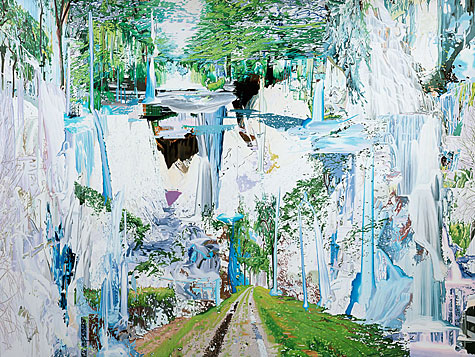
The Mildred Lane Kemper Art Museum has received an extraordinary gift from the David Woods Kemper Memorial Foundation to support the acquisition of new works by artists living and working in Germany.
“Over the last two decades, Germany has re-emerged as an intellectual and creative center of the international art world,” says Sabine Eckmann, the William T. Kemper Director and Chief Curator of the Kemper Art Museum.
“These new acquisitions will strongly enhance the museum’s outstanding collection of contemporary German art. They also provide a fresh opportunity to explore how artists have responded, both explicitly and implicitly, to the acceleration of globalization and its broad effects on culture, commerce and society.”
This fall, the Kemper Art Museum will present Precarious Worlds: Contemporary Art From Germany. The exhibition will feature the first five works acquired thanks to the Kemper gift: monumentally scaled pieces by Franz Ackermann, Thomas Demand, Sergej Jensen, Charline von Heyl and Corinne Wasmuht.
Also on view will be significant works, already in the permanent collection by Cosima von Bonin, Isa Genzken, Michel Majerus, Manfred Pernice and Wolfgang Tillmans as well as a major installation, on loan for the exhibition, by Hans-Peter Feldmann. Together, these artists mediate the sweeping and sometimes paradoxical changes that have marked German life in the years since the fall of the Berlin Wall as well as the worldwide effects, at once shattering and homogenizing, wrought by digital culture and technology.
Several of these artists embrace conditions of instability and fragility without reference to particular contemporary or historical events. For example, Sergej Jensen creates delicate textile objects from found pieces of fabric, while Franz Ackermann explores the cultural centrality of the tourist as urban wanderer. In Untitled (yet), a large canvas from 2009, Ackermann depicts a cable car floating through a series of bright, though unidentifiable, topographies, suggesting both the growing ubiquity of worldwide travel and, in the work’s garish color scheme, the legacy of German Expressionism.
Thomas Demand and Wolfgang Tillmans induce subtle unease with large-scale photographic works that are deliberately devoid of real-world referents. For Shed (2006), Demand constructed, photographed and then destroyed a life-size paper model of a laundry room, thus unmooring the final image from any original source.
Tillmans, meanwhile, produces photographs without the use of a camera. For Silver 71 (2008), he exposed photosensitive paper to dirt, metal dust and light over a period of days. And for his Wald (Briol II) (2008), he photocopied a photograph of a man walking into a forest — a highly symbolic image in German art and culture, charged with shades of nationalism — then greatly enlarged the print, blurring its meaning both literally and metaphorically.
Corinne Wasmuht and Michel Majerus respond to the flickering effects of digitization with large-scale paintings that deny viewers a stable, unchanging perspective. Wasmuht’s Llangancuo Falls (2008) is an abstracted landscape in which layers of paint, slowly and meticulously applied, begin to simulate the glittering pixelization of the digital screen.
Majerus’s mm6 (2001) belongs to a series of paintings based on a digital film that mimics the electronic displays used at Berlin’s annual “Love Parade” (2001–07), a techno-music festival. Replacing the “Love Parade” logo with the words “Michel Majerus,” mm6 recalls the flash of the electronic billboard yet also, paradoxically, fixes it in time, transforming the most ephemeral of images into monumental self-portraiture.
“Common to all of these works is an awareness of precariousness as a defining contemporary condition,” Eckmann says. “The use of ephemeral materials; a sense of history and memory as fluid and instable and of ‘real things’ as absent; the effects of increased mobility on mental states that have become transitory and subject to constant change; and nonunified visualizations that destabilize perception — these characterize the means by which these large-scale artworks visualize conditions of precariousness.”
Mildred Lane Kemper Art Museum
The Mildred Lane Kemper Art Museum, part of Washington University’s Sam Fox School of Design & Visual Arts, is committed to furthering critical thinking and visual literacy through a vital program of exhibitions, publications and accompanying events. The museum dates back to 1881, making it the oldest art museum west of the Mississippi River. Today it boasts one of the finest university collections in the United States.
Support for Precarious Worlds: Contemporary Art From Germany was generously provided by James M. Kemper Jr., the David Woods Kemper Memorial Foundation and the William T. Kemper Foundation.
Precarious Worlds: Contemporary Art From Germany will open with a public reception from 7 to 9 p.m. Friday, Sept. 9, and will remain on view through Jan. 9, 2012. Both the reception and the exhibition are free and open to the public.
The Kemper Art Museum is located on Washington University’s Danforth Campus, immediately adjacent to Steinberg Hall, near the intersection of Skinker and Forsyth boulevards. Regular hours are 11 a.m. to 6 p.m. Mondays, Wednesdays and Thursdays; 11 a.m. to 8 p.m. Fridays; and 11 a.m. to 6 p.m. Saturdays and Sundays. The museum is closed Tuesdays.
For more information, call (314) 935-4523 or visit kemperartmuseum.wustl.edu.
|
WHO: Mildred Lane Kemper Art Museum WHAT: Exhibition, Precarious Worlds: Contemporary Art From Germany WHEN: Sept. 9 to Jan. 9, 2012; Opening 7 to 9 p.m. Friday, Sept. 9 WHERE: Mildred Lane Kemper Art Museum, Washington University, near the intersection of Forsyth and Skinker boulevards HOURS: 11 a.m. to 6 p.m. Monday, Wednesday and Thursdays; 11 a.m. to 8 p.m. Fridays; 11 a.m. to 6 p.m. Saturdays and Sundays. Closed Tuesdays. COST: Free and open to the public INFORMATION: (314) 935-4523 or kemperartmuseum@wustl.edu
|